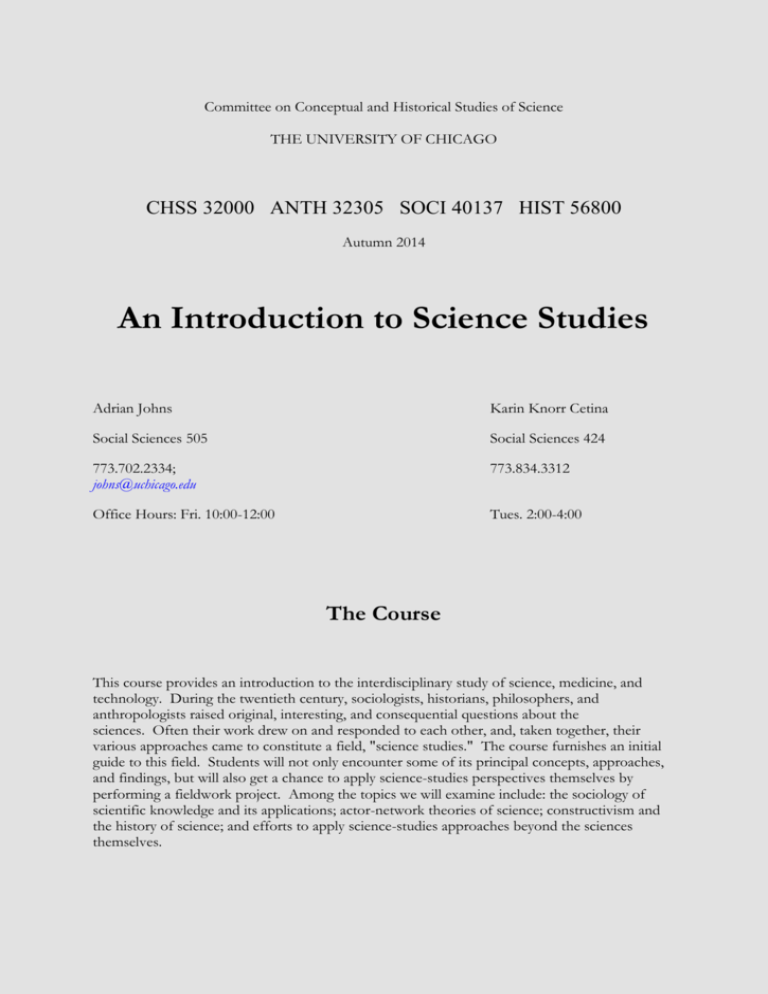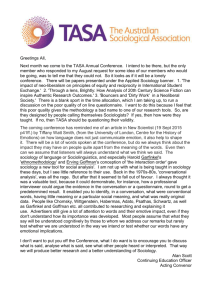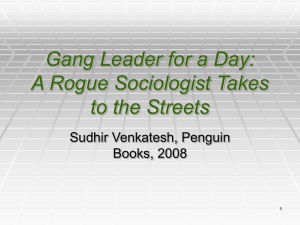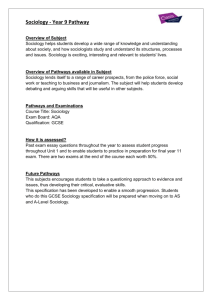Committee on Conceptual and Historical Studies of Science
advertisement

Committee on Conceptual and Historical Studies of Science THE UNIVERSITY OF CHICAGO CHSS 32000 ANTH 32305 SOCI 40137 HIST 56800 Autumn 2014 An Introduction to Science Studies Adrian Johns Karin Knorr Cetina Social Sciences 505 Social Sciences 424 773.702.2334; johns@uchicago.edu 773.834.3312 Office Hours: Fri. 10:00-12:00 Tues. 2:00-4:00 The Course This course provides an introduction to the interdisciplinary study of science, medicine, and technology. During the twentieth century, sociologists, historians, philosophers, and anthropologists raised original, interesting, and consequential questions about the sciences. Often their work drew on and responded to each other, and, taken together, their various approaches came to constitute a field, "science studies." The course furnishes an initial guide to this field. Students will not only encounter some of its principal concepts, approaches, and findings, but will also get a chance to apply science-studies perspectives themselves by performing a fieldwork project. Among the topics we will examine include: the sociology of scientific knowledge and its applications; actor-network theories of science; constructivism and the history of science; and efforts to apply science-studies approaches beyond the sciences themselves. Required Readings Members are expected to provide themselves with the following texts, which should be available at the Seminary Co-op: Latour, Bruno. 1987. Science in Action. Knorr Cetina, Karin. 1999. Epistemic Cultures. Other readings are listed below. Those with a double asterisk (**) are compulsory; others are helpful but not absolutely required. These readings should be available via the web, either on ereserve or in the ‘Course Documents’ section of our Chalk site (https://chalk9.uchicago.edu/). Course Requirements DISCUSSIONS AND QUESTIONS Meetings take place every week on Wednesdays, 9:30-12:20, in WB130. Students are expected to read and reflect on the assigned readings before class, to attend each class, and to participate in class discussion. Students are also required to develop a short, one- to two-paragraph document proposing one or more discussion questions before each class. They should upload this to the relevant section of the ‘Discussion Board’ part of the Chalk site by 9pm on the Tuesday evening prior to each Wednesday session. This document should pose and briefly motivate a question or questions, often through the development of a specific puzzle or problem in the text. It should not summarize the text’s own argument except in so far as this is necessary to convey the student’s point. For example, a question might look like this: In “The Normative Structure of Science,” Merton states that “The ethos of science is that affectively toned complex of values and norms which is held to be binding on the man of science. The norms are expressed in the form of prescriptions, proscriptions, preferences, and permissions. They are legitimized in terms of institutional values. These imperatives, transmitted by precept and example and reinforced by sanctions are in varying degrees internalized by the scientist, thus fashioning his scientific conscience or, if one prefers the latter-day phrase, his super-ego.” These values supposedly “derive from the goal and the methods” of science—“the extension of certified knowledge” through logically consistency and empirical confirmation. But what exactly does this mean—what is the ontology and etiology of the four norms that Merton goes on to develop in this paper (and the other he adds in his article on priorities)—what are they and where do they come from? Specifically, are norms attitudes, morals, rules or means; are they held by every scientist, “average” scientists, exemplary scientists, or only those who share “the goal and the methods” of science Merton describes? Do they differ from the norms of comparable nonscientists (e.g., engineers, lawyers, plumbers)? And did they result from a rational social contract to further preexisting goals and practices of science, did they coevolve as homologues, or do science’s shared goals, practices and norms simply coexist as epiphenomena of some deeper, “Western” ethos of progress. These submissions are visible to all participants in the course. This is by design: the idea is that an online ‘conversation’ in parallel with the classroom sessions may develop as we proceed. Note that the Chalk site gives participants the opportunity to reply to posts, thus creating threads on particular topics. We encourage you all to use this facility – it is not a requirement, but everyone may find it helpful. TERM PAPER Students will be expected to produce a final project. This should be a roughly 20-page (doublespaced) research paper that engages with issues raised by the course, and which includes an empirical component. The empirical component might include observation of a research or discourse setting; interviews; the shadowing of a particular researcher; or an archival project. Instructors will help devise possible research tropics. At least 10 distinct primary sources should be used in your analysis (e.g., a research articles, notebooks, commentary or instruments from the time period of investigation). Essays should have a guiding organization and deploy signposting (e.g., an introduction with a roadmap and conclusion) and standard referencing. Students should have prepared by November 5 a one-page (600 word), single-spaced “pitch” that describes their chosen topics and the broad arguments they expect to make. They will briefly present their early work in class, involving a rendition of their questions/arguments, the significance of these in the context of course readings, and the data they mean to use to address them. Final papers/exhibits must be turned in no later than December 19. We understand that this is past the conventional grading deadline, but we want students to have time to develop their work after course readings have been completed. They may, of course, be turned in earlier. Final grades are constituted as follows: Class participation and reading questions 20% Term paper 80% Calendar of Lecture and Discussion Topics and Reading Assignments Oct. 1. Introduction Course syllabus Oct. 8. The beginnings of the modern sociology of Science **Merton, Robert K. 1973 [1942]. “The Normative Structure of Science,” in Norman Storer (ed.), The Sociology of Science: Theoretical and Empirical Investigations. University of Chicago Press, pp. 267-278. **Merton. 1973 [1957]. “Priorities in Scientific Discovery,” in The Sociology of Science, pp. 286-324. **Zilsel, Edgar. 1942. “The Sociological Roots of Science.” American Journal of Sociology 47, pp. 544-562. Bucchi, M. 2004. Science in Society. An Introduction to Social Studies of Science. London, Routledge, ch. 1: “The Development of Modern Science and the Birth of the Sociology of Science,” 7-23. Oct. 15. The Sociology of Scientific Knowledge **Bloor, David. 1976/1991. Knowledge and social imagery. University of Chicago Press, pp. 3-23, 131-56 (chs. 1, 7). **Collins, Harry. 1975. “The Seven Sexes: A Study in the Sociology of a Phenomenon, or the Replication of Experiments in Physics,” Sociology 9, pp. 205-224. **Fleck, Ludwig. 1979 [1935]. Genesis and development of a scientific fact. Chicago: University of Chicago Press, pp.38-51, 82-125. Pickering, Andrew. 1981. “The hunting of the quark.” Isis 72, pp.216-36. MacKenzie, D. 1978. "Statistical Theory and Social Interest: A Case Study." Social Studies of Science 8: 35-83. Oct 22. Actors, networks, boundaries, and translations ** Latour, Science In Action, pp. 103-44, 179-213, 215-57 (chs. 3, 5, 6) ** Star, S. L. and J. Griesemer. 1989. "Institutional Ecology, 'Translations' and Boundary Objects: Amateurs and Professionals in Berkeley´s Museum of Vertebrate Zoology, 190739." Social Studies of Science 19: 387-420. Galison, P. 1997. Image and Logic. A Material Culture of Microphysics. Chicago, The University of Chicago Press. Ch. 9, pp. 781-844. Latour, B. and S. Woolgar. 1979. Laboratory Life. The Construction of Scientific Facts. Beverly Hills, Sage, ch. 5: Cycles of Credit, 187-233. Oct 29. Places and thresholds: the laboratory **Latour, Science in Action, 63-100, 215-257. **Knorr Cetina, Epistemic Cultures, 26-45. **Latour, Bruno. 1983. “Give Me a Laboratory and I Will Raise the World,” in K. KnorrCetina and M. Mulkay (eds.), Science Observed: Perspectives on the Social Study of Science. London: Sage, pp. 141–70. Hirschauer, S. 1991. "The Manufacture of Bodies in Surgery." Social Studies of Science 21: 279-319. Shapin, S. 1988. The House of Experiment in Seventeenth-Century England. Isis 79:373404. Nov. 5. Virtue and Credit **NB: 600 word research “pitch” due in class ** **Shapin, S. and Simon J. Schaffer. 1985. Leviathan and the Air-Pump: Hobbes, Boyle, and the Experimental Life. Princeton: Princeton University Press, pp. 22-79, 110-54. Shapin, Steven. 1994. A Social History of Truth: Civility and Science in 17th Century England. University of Chicago Press, pp. 3-41, 243-309, 409-17. Shapin, S. 2008. The Scientific life: a moral history of a late modern vocation. Chicago: University of Chicago Press. 165-208. Nov. 12. Standpoints in Theory and Practice: Gender, Race, and Others **L. Schiebinger, Plants and Empire: Colonial Bioprospecting in the Atlantic World (Harvard, 2004), Ch 2 (73-104). **S. Harding, “From the Woman Question to the Science Question,” The Science Question in Feminism (Ithaca: Cornell University Press, 1986), 15-29. D. Haraway, "Situated Knowledges: The Science Question in Feminism and the Privilege of Partial Perspective," Feminist Studies 14(3) (1988), 575-599. L. Schiebinger, “Has Feminism Changed Science?” Signs: Journal of Women in Culture and Society, 25 (2000),1171-6. C. Hayden, When Nature Goes Public: The Making and Unmaking of Bioprospecting in Mexico (Princeton, 2003), Ch. 1 (19-47). S. Epstein, Inclusion: The Politics of Difference in Medical Research (Chicago, 2007), Ch 2 (30-52). Nov. 19. Algorithms and Models or Expert and lay knowledge: Public and popular science We will decide which topic to pursue depending on student interests. For Expert and Lay Knowledge, the readings would be: **Gieryn, T. F. 1999. Epilogue: Home to Roost: Science Wars as Boundary Work. Cultural Boundaries of Science: Credibility on the Line. Chicago, University of Chicago Press: 336-363. **Epstein, S. 1996. Impure Science: AIDS, Activism, and the Politics of Knowledge: University of California Press. **A. Winter, Memory: Fragments of a Modern History (Chicago, 2012), Ch 10 (225-55). A. Secord, “Science in the Pub: Artisan Botanists in Early Nineteenth-century Lancashire,” History of science 32 (1994), 269-315. A. Johns, “Experimenting with Print,” Piracy (Chicago, 2009), ch 4 (57-82). Nov. 26. No meeting – Thanksgiving week Dec. 3. Information and Economic Knowledge **MacKenzie, Donald. 2001. “Physics and Finance: S-Terms and Modern Finance as a Topic for Science Studies,” Science, Technology, & Human Values 26: 115-144. **Callon, M. and F. Muniesa. 2005. "Economic Markets as Calculative Collective Devices." Organization Studies 26(8): 1229-1250. MacKenzie, D. and M. Yuval 2003. "Constructing Markets, Performing Theory: The Historical Sociology of a Financial Derivatives Exchange." American Journal of Sociology 109(1): 107-145. Callon, M. 1998. Introduction: The Embeddedness of Economic Markets in Economies. The Laws of the Markets. Oxford, Malden, MA, Blackwell Publishers/Sociological Review: 1-57. Carruthers, B. and W. Espenland. 1991. "Accounting for Rationality: Double-Entry Bookkeeping and the Rhetoric of Economic Rationality." American Journal of Sociology 97(1): 31-69. Knorr Cetina, K. 2009. “The Architecture of Information in Financial Markets." To appear as Chapter 6 in Maverick Markets: Cultural Structures of a Global Financial Form. Geertz, C. 1978. "The Bazaar Economy: Information and Search in Peasant Marketing." American Economic Review 68: 28-32.






